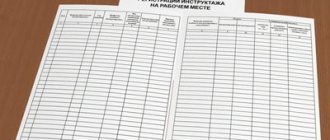Almost every position and profession requires compliance with certain safety measures. The employer undertakes to train its employees in the rules.
For this purpose, a large volume of instructions is being developed. The Labor Code determines that the employer must be involved in the process of drawing up safety rules. But not all companies have taken such measures.
Often, instructions that are used in an organization become invalid because they were adopted too long ago.
What is a labor safety instruction and the procedure for its development
Documentation of such a plan should not be regarded as something that helps to avoid problems with the labor inspectorate.
These local acts contain requirements and establish rules that help eliminate injuries, mutilations and loss of ability to work when performing labor functions in production, contracting and other areas of organizations, within their territories. In addition, they discipline subordinates and indicate the professionalism of management.
Types of OT instructions
Document structure
Standard instructions developed by state labor protection authorities consist of five main sections. They set rules at different stages of work:
- General safety rules;
- Requirements before starting work;
- Security on the main part of operations;
- Compliance with requirements at the end of the process;
- Actions in case of emergencies.
The same structure should be followed in the document that is developed at the enterprise. If there are production features that need to be included in the document and highlighted as a separate section, they can be added to the instructions.
There are these types of OT instructions:
Contents of occupational safety instructions for the specialty
As for standard industry and inter-industry instructions. Their development is carried out by experienced specialists in this field, based on an analysis of injuries received and diseases that have developed associated with the type of activity, therefore it is recommended that they be used as a model for writing local acts for the professions available in the staffing table.
Note! You should not copy standard analogues without understanding, since they contain general information, as well as partially inappropriate, redundant, outdated information, or not all required information.
Subject to agreement with the federal executive authorities, it is allowed to use industry documentation as fundamental when developing specialists from companies of other types of activities, but in relation to the corresponding professions and types of work processes.
The structure of the instructions must contain the following chapters:
Helpful Instructions
During the development process, standard recommendations are specified and supplemented based on specific labor characteristics and various risks. The instructions drawn up should maximally protect not only long-established processes, but also new production facilities that are opening (at the same time, it is permissible to write temporary local acts, the main thing is to exclude the possibility of injury when using machines, conveyors, power tools, and other equipment).
Draft instructions that have been agreed upon and approved:
- issued to job seekers for informational purposes;
- are hung near the labor processes described in them;
- located in other publicly accessible areas.
In general, the instructions can be given to define local acts that reflect in detail the legal regulations and specialization of companies, drawn up taking into account known accidents at similar enterprises. They are considered among the basic documents that all personnel (from the director to the technicians) must know and unconditionally follow. Those who violate the requirements set out in them are subject to penalties and penalties:
- Disciplinary
- Material
- Civil law
- Administrative
- Criminal in nature (Article 419 of the Labor Code of the Russian Federation)
Note! The method of attraction is regulated by the Federal Law, and the measures taken depend on the severity of the consequences.
Participation of officials
However, if you turn to the legislation and carefully study the responsibilities assigned to specialists involved in labor protection, it will turn out differently. By law, the employer ensures the development and approval of labor protection instructions for employees. This is obvious based on Article 212 of the Labor Code of the Russian Federation. There is no link to a specific position in the article. Naturally, the manager himself will not do this, but will decide who among his subordinates develops labor safety instructions.
Next, you should carefully study the job responsibilities of representatives of the engineering and technical service in order to understand who should develop labor safety instructions. The recommendations for the work of the occupational safety service indicate what operations the person responsible for occupational safety should perform when instructions are developed for workers:
- Make a list of professions and positions of the organization’s employees for which it is necessary to prepare documents;
- Provide assistance to department heads in developing labor safety instructions.
Consequently, the development of labor protection instructions should be entrusted to the heads of structural units. This is the correct solution to the problem. The shop foreman or site manager visits the department assigned to him every day and knows better than others the conditions under which workers perform their duties. An occupational safety engineer may not know all the intricacies of the profession and will not take into account important aspects of the work process when drawing up a document. And he must take into account all the nuances that may happen in production and prepare recommendations for the employee on the correct behavior. Employees responsible for developing instructions must be assigned by order of the manager. In addition, the order should indicate a list of professions and the time frame within which labor protection instructions are developed.
Who develops labor safety instructions
Instructions on labor protection by profession and type of work
Often in the practice of labor relations, a conflict arises regarding the preparation and updating of IOT. The management of sites and other structural units of organizations does not want to work on instructions and is trying to oblige the OT service to deal with them. Let's figure out who has the truth.
In paragraph 7.16 of section III prescribed in the Resolution of the Ministry of Labor No. 14 as amended. as of February 12, 2014, it is said that employees of the safety department provide all possible assistance to officials managing departments in the process of writing or adjusting instructions. Consequently, this work should be attributed to the competence of the latter, regardless of the fact that the instructions are indirect.
The preamble to Article 212 of the Labor Code obliges managers to provide subordinates with instructions on occupational safety and their safety. Drawing up such documents is a complex and time-consuming task, so heads of institutions often order their production from specialized companies.
If it is decided to entrust the development to an official of the organization, then the appointment is made on the basis of an order. When selecting a contractor, employees of occupational safety services and other persons who endorse such documentation are not considered.
Procedure for development and content of instructions
The employer’s duty, regardless of the type of activity and form of ownership, is to ensure the safety of workplaces, production premises, enterprise territory, construction or other sites where work is carried out on his behalf.
Fire safety measures: development procedure at the enterprise
Including:
- when operating equipment;
- execution of the technical process;
- use of tools, materials, raw materials.
The normative act establishing occupational safety requirements when performing all types of work is the labor protection instruction. The document, which takes into account the typical causes of accidents and occupational diseases, defines safe methods and techniques. Its adoption is a critical step in creating healthy and safe production.
Note! Regulatory instructions are developed for all professions included in the staffing table and for all types of work that are carried out in production, construction and installation, trade, warehouse and transport enterprises, in research and design institutes, in design bureaus, repair and restoration workshops, in medical and children's institutions.
General requirements
A short list of general OT requirements that must be included in the instructions:
- inner order rules;
- work schedule and rest;
- dangerous and harmful factors, they are determined for specific professions and types of work;
- sanitary standards that must be observed when performing work;
- a list of work clothes, shoes, and protective equipment that a person is provided with according to established rules and regulations;
- the procedure for reporting to a superior about cases of injury or malfunction of technical equipment.
Safety instructions are drawn up for each profession or type of work
The instructions regulate a certain procedure for action in different situations.
Before starting work
Describes the specifics of preparing the workplace and means of ind. protection. Equipment, instrumentation, starting, braking, protective, blocking devices, alarms, grounding, and primary fire extinguishing equipment are checked. The procedure for checking the materials needed to begin work is indicated. The process of receiving and transferring a shift during a continuous work process, in the event of equipment malfunction or technological process failure, is described.
During work
The sequence of actions and safe methods of operating the equipment are regulated. The procedure for using raw materials, tools, devices, vehicles, lifts, mechanisms, and containers is described. The procedure for maintaining the workplace is separately mentioned. The conditions and factors under which work must be stopped immediately, as well as actions to prevent emergency situations, are listed.
In emergency situations
Actions in case of emergency, principles of first aid for injuries, poisoning, and other health damage are indicated.
Upon completion of work
The algorithm for shutting down, disassembling, cleaning and lubricating machines, equipment, and mechanisms is regulated. The need for waste collection is mentioned. Specifies the procedure for notifying the work manager of safety problems discovered during the production process.
Important! The content can be supplemented by the employer taking into account production features; the document may include additional sections.
The procedure for agreeing and approving instructions
Documents on labor protection in the organization: list
We figured out who develops labor safety instructions in an organization. Now let's look at the sequence of actions step by step.
- The contractor, taking into account the staffing schedule, the specifics of the technical processes and the types of units involved, prepares a list of necessary instructions, signs and provides it to the head of the enterprise for review.
- Having considered this list, the manager makes a resolution to forward it to the compilers for work.
- These responsible persons, in turn, check the list and begin writing the missing instructions.
Note! When compiling, they are guided by standard instructions or rules, use methodological recommendations of the Ministry of Labor and Social Development of the Russian Federation No. 80 dated December 17, 2002, take the necessary information from existing operational, technological, repair documents and recommendations of equipment manufacturers.
- Finished draft instructions are signed by the contractor and endorsed on the reverse side by interested officials.
Figure 4 Signature of instructions
- The endorsed documents are sent to the employer, who sends them for approval to the elected primary trade union body. In this case, title pages must contain the following information.
How to endorse instructions
- At the final stage, the agreed draft documents are approved by the manager and distributed to the relevant services (divisions, areas) for acceptance for execution and bringing to the attention of personnel.
- Those responsible for safety and the availability of instructions at department workplaces adjust their own lists to take into account updates.
The review should be carried out:
- periodically (once every five years);
- in connection with changes to existing rules or standard documentation;
- after the modernization of production or the introduction of other innovations that affected the working environment;
- after accidents (not necessarily in this institution) or identified occupational diseases.
Instructions may be revised ahead of schedule:
- when revising intersectoral and sectoral rules and standard instructions on labor protection;
- when the working conditions of employees change;
- when introducing new technology;
- based on the results of the analysis of materials from the investigation of accidents, industrial accidents and occupational diseases;
- at the request of representatives of labor authorities of constituent entities of the Russian Federation or the federal labor inspectorate.
If during the period of validity of the instruction the working conditions of the employee have not changed, then by order (instruction) on the organization, establishment and decision of the trade union committee, the validity of the instruction is extended for the next period, about which an entry is made on the first page of the instruction (the “Revised” stamp is placed, date and signature person responsible for revising the instructions).
Approved instructions of an organization or institution are registered in the journal of instructions for the organization or institution in accordance with the procedure established by the Ministry of Labor of Russia.
The head of an organization or institution must constantly keep a set of current instructions, as well as a list of these instructions approved by him.
One set of instructions may be provided by a trade union committee of an organization, an institution or a representative body of workers, a labor protection commissioner, or a labor protection committee (commission).
All employees, heads of offices, workshops and other departments must be provided with instructions.
The location of instructions for employees, a list of them and a log of the issuance of instructions is determined by the head of the organization or institution, taking into account the availability of ease of familiarization with them.
Instructions can be handed out to employees or posted at their workplaces, taking into account the need to ensure simplicity and ease of familiarization with them.
If the information was useful, leave comments and share the link to this article on your social networks. Thank you!
Who approves labor safety instructions?
Coordination is carried out by elected trade union organizations acting in the interests of workers:
- primary;
- representative (if stipulated by the collective agreement or agreement);
- other structures vested with such powers.
The sequence of approval is regulated by Art. 372 of the Labor Code, according to which officials who have received draft instructions must proceed from the deadlines allotted by law and study the received documents no longer than 5 working days. The result of the review is documented in writing by an employee of the approving body and sent to the head of the compilers. The response must contain a reasoned conclusion on the substance of the instructions.
If the elected body believes that the developed projects do not provide adequate safety for workers, then it also sends a written refusal containing comments and suggestions. Within three working days, the head of the enterprise (institution) can apply for additional consultations and involve developers in correcting shortcomings in order to reach a compromise.
Additional Information! If the employer does not agree with the comments, then the controversial issues are recorded. At this stage, the manager has the right to approve instructions (including those that have not been approved) on labor protection, and the body that reviewed them has the right to send a complaint to the labor inspectorate or the courts for further proceedings.
In the section “Occupational safety requirements upon completion of work” it is recommended to reflect:
- procedure for safe shutdown, shutdown, disassembly, cleaning and lubrication of equipment, devices, machines, mechanisms and equipment,
- procedure for handing over a workplace;
- requirement of personal hygiene;
- procedure for notifying the manager of all deficiencies discovered during work
The text of the instructions should be concise, clear and not subject to different interpretations.
The terms used in the instructions must correspond to the terminology adopted in the relevant legislative acts, GOSTs, technical regulations, and other documents on labor protection.
The revision of instructions for employees is organized by the employer (head of the institution, organization)
The instructions must be reviewed at least once every 5 years.
Carrying out approvals
Instructions for workers are developed jointly with specialists involved in equipping workplaces, operating production equipment without harm to health, and preventing occupational injuries. Technologists, engineers, and labor protection specialists check the contents of the document and put their signature on the last page.
Important! If the enterprise has an elected trade union organization that unites at least 50% of employees, its opinion must be taken into account when drawing up instructions. The obligation to coordinate instructions with the trade union must be reflected when adopting a collective agreement.
Draft documents must be sent to the trade union committee with a covering letter attached. The response of the trade union organization must also be in writing. If there is no trade union body at the enterprise, you need to obtain the approval of the labor council. After signing by all involved persons, the document is approved by the manager. For this purpose, a separate order is drawn up for the enterprise, to which an extract from the minutes of the meeting of the trade union committee is attached. The validity period of the instructions begins from the date the order is issued and lasts five years. If there is a need to make additions, the procedure for registration will be the same as for the initial creation of documents. After five years of use, the document can be re-approved in the same form. Professions and safety requirements remain unchanged, so adjustments to instructions are not necessary. The developer draws up a validity extension sheet and attaches it to the original.
When issuing instructions for individual professions, the approval of specialists from other departments may be required. So for an employee whose work involves hazardous chemicals, the instructions must be agreed upon with sanitary services. To carry out work with flammable substances, the approval of the fire department is required.








